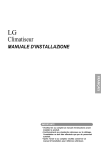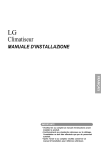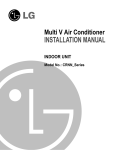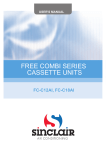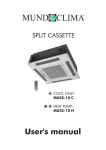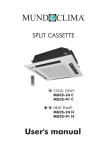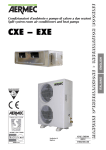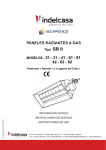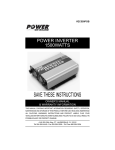Download Mitsubishi Electric PUMY-P-YHMC Unit installation
Transcript
CEILING CASSETTE TYPE AIR CONDITIONERS
INSTALLATION INSTRUCTIONS
Indoor Unit
Anti-bacteria filter
Air
Intake
Air Outlet
Outdoor Unit
Air Intake
(side, rear)
Air Intake
(side, rear)
Air Outlet
Air Outlet
Control cover
Connecting wire
Connection Piping
Drain hose
Air Intake
(side, rear)
Control cover
Connecting wire
Connection Piping
Drain hose
Connecting Wire
Power Wire
Air Outlet
Vents
48K
Connection Tube
Drain Hose
Cooling & Heating Model has
included Drain Elbow
P/No. : 3828A20110M
ENGLISH
• Please read this instruction sheet completely before installing the product.
• When the power cord is damaged, replacement work should be performed by authorized personnel
only.
• Installation work should be performed in accordance with national wiring standards by authorized
personnel only.
OUT-LINE OF INSTALLATION
1.The following should be always observed for safety ...............................3
2.Installation of Indoor, Outdoor Unit ............................................................4
Installation Works
Installation Parts
Required Tools
1) Selection of the best location ......................4
• Connecting cable
• Level
2) Ceiling opening dimensions and hanging
bolt location(unit: mm).................................5
• Pipes: Gas side
Liquid side
• Screw driver
3) The Indoor Unit Installation .........................6
• Hanging Bolt
(W 3/8 or M10 length
650mm)
4) Remote Controller Installation ....................6
5) Wiring Connection.......................................8
ELECTRICAL WIRING................................9
CONNECTING THE CABLE TO OUTDOOR UNIT ......9
6) Connecting Pipes to the Indoor Unit .........10
PIPING CONNECTION.............................11
• Insulated drain hose
• Additional Drain hose
(Inner Dia.............32mm)
• Electric drill
• Hole core drill (ø70mm)
• Flaring Tools set
• Torque Wrenches
• Hexagonal Wrench
(4mm, 5mm)
• Gas-leak detector
7) Installation of Decorative Panel.................12
8) Indoor Unit Drain Piping ............................13
HEAT INSULATION...................................14
FORM THE PIPINGS................................14
3. Test running ..............................................................................................15
1) PRECAUTIONS IN TEST RUN.................15
CHECK THE FOLLOWING ITEMS WHEN
INSTALLATION IS COMPLETE ................15
2) Connection of power supply......................16
3) Evaluation of the performance ..................16
• Owner’s Manual
• Thermometer
4. Auxiliary operation ...................................................................................17
1) Two thermistor system ..............................17
2) Ajusting to the height of ceiling .................18
3) Group control (optional wiring)..................19
4) Central control (optional)...........................20
2
1. The following should be always observed for safety
WARNING
Could lead to death, serious injury, etc.
CAUTION
Could lead to serious injury in particular environments when operated incorrectly.
• After reading this manual, be sure to keep it together with the instruction manual in a handy place .
WARNING
Perform the installation securely referring to the
installation manual.
Do not install it yourself (customer).
• Incomplete installation could cause injury due to fire, electric shock,
the unit falling or a leakage of water. Consult the dealer from whom
you purchased the unit or special installer.
• Incomplete installation could cause a personal injury due to
fire, electric shock, the unit falling or a leakage of water.
Install the unit securely in a place which can bear the
weight of the unit.
Perform electrical work according to the installation
manual and be sure to use an exclusive circuit.
• When installed in an insufficient strong place, the unit may fall
and result in serious problem.
• If the capacity of the power circuit is insufficient or there is
incomplete electrical work, it could result in a fire or an electric
shock.
Use the specified wires to connect the indoor and the
outdoor units securely and attach the wires firmly to
the terminal board connecting sections so the stress
of the wires is not applied to the sections.
Attach the electrical part cover to the indoor unit and
the service panel to the outdoor unit securely.
• Not being attached securely, it may cause electric problem or
electric shock due to dust or water etc.
• Incomplete connecting and fixing could cause fire.
Be sure to use the part provided or specified parts for
the installation work.
Check that the refrigerant gas do not leak after
installation is completed.
• The use of defective parts could cause an injury or leakage of
water due to a fire, electric shock, the unit falling, etc.
CAUTION
Perform the drainage/piping work securely
according to the installation manual.
Perform grounding
• If there is a defect in the drainage/piping work, water
could drop from the unit and household goods could be
wet and damaged.
• Do not connect the ground wire to a gas pipe, water pipe arrester or
telephone ground wire. Defective grounding could cause an electric
shock.
Do not install the unit in a place where an
inflammable gas leaks.
• If gas leaks and accumulates in the area surrounding the unit, it
could cause an explosion.
3
ENGLISH
• Be sure to read "THE FOLLOWING SHOULD BE ALWAYS OBSERVED FOR SAFETY" before
installing the air conditioner.
• Be sure to observe the cautions specified here as they include important items related to safety.
• The indications and meanings are as follows.
yyy
;;;
;;;
yyy
;y;;
Ceiling
Ceiling Board
50 or
more
Ceiling Board
30 or less
• There should not be any heat source or
steam near the unit.
• There should not be any obstacles to
prevent the air circulation.
• A place where air circulation in the room will
be good.
• A place where drainage can be easily
obtained.
• A place where noise prevention is taken into
consideration.
• Do not install the unit near the door way.
• Ensure the spaces indicated by arrows from
the wall, ceiling, or other obstacles.
• The indoor unit must keep the maintenance
space.
50 or
more
Above 250
400 or less
1) Indoor unit
100
or more
1. Selection of the best location
30 or more
2. Installation of Indoor, Outdoor Unit
Unit:cm
Floor
2) Outdoor unit
• If an awning is built over the unit to prevent
direct sunlight or rain exposure, be careful
that heat radiation from the condenser is not
restricted.
• There should not be any animals or plants
which could be affected by hot air
discharged.
• Ensure the spaces indicated by arrows from
the wall, ceiling, fence or other obstacles.
More than
30cm
Su
nro
of
More than
30cm
Fe
ob nce
sta or
cle
s
More than 50cm
More than 70cm
3) Piping length and the elevation
Pipe Size
Length
(m)
Elevation
CAPACITY
(m) * Additional
refrigerant
Max.
(g/m)
GAS
LIQUID
Rated
Max.
Rated
18K Btu/h
5/8"
1/4"
7.5
50
5
30
25
24K Btu/h
5/8"
1/4"
7.5
50
5
30
30
36K Btu/h 1 phase
5/8"
1/4"
7.5
50
5
30
45
36K Btu/h 3 phase
5/8"
3/8"
7.5
50
5
30
60
48K Btu/h
3/4"
3/8"
7.5
50
5
30
60
54K Btu/h
3/4"
1/2"
7.5
50
5
30
70
• Rated performance for refrigerant line length of: 7.5m
• If 18K Model is installed at a distance of 15m, 187.5g of refrigerant
should be added ..................................................................(15-7.5)x25g
4
Indoor unit
A
B
Outdoor unit
2. Ceiling opening dimensions and hanging bolt location
• The dimensions of the paper model for installing
are the same as those of the ceiling opening
dimensions.
600 (Ceiling opening)
75
450 (Hanging bolt)
Ceiling
75
570 Unit size
570 Unit size
600 (Ceiling opening)
39.5
Level gauge
(18K/24K)
Unit:mm
CAUTION
• This air-conditioner uses a drain pump.
• Horizontly install the unit using a level gauge.
• During the installation, care should be taken not to
damage electric wires.
Ceiling board
• Select and mark the position for fixing bolts and piping hole.
• Decide the position for fixing bolts slightly tilted to the drain
direction after considering the direction of drain hose.
• Drill the hole for anchor bolt on the wall.
NOTE:
• Avoid the following installatation location.
1. Such places as restaurants and kitchen where considerable amount of oil steam and flour is
generated.
These may cause heat exchange efficiency reduction, or water drops, drain pump mal-function.
In these cases, take the following actions;
• Make sure that ventilation fan is enough to cover all noxious gases from this place.
• Ensure the enough distance from cooking room to install the air conditioner in such a place where it
may not suck oily steam.
Air conditioner
Take enough
distance
Use the ventilation fan
for smoke-collecting
hood with sufficient
capacity.
Cooking table
2. Avoid installng air conditioner in such circumstances where cooking oil or iron powder is generated.
3. Avoid places where inflammable gas is generated.
4. Avoid place where noxious gas is generated.
5. Avoid places near high frequency generators.
5
ENGLISH
521(Hanging bolt)
39.5
3. The Indoor Unit Installation
Ceiling
Nut
(W3/8 or M10)
Flat washer for M10
(accessory)
Ceiling board
Spring washer
(M10)
Flat washer for M10
(accessory)
Nut
(W3/8 or M10)
Air Conditioner body
Ceiling board
Paper model
for installation
Adjust the same height
• The following parts is option.
Hanging Bolt - W 3/8 or M10
Nut
- W 3/8 or M10
Spring Washer - M10
Plate Washer - M10
150mm
Keep the length of the bolt
from the bracket to 40mm
Hanging bolt
(W3/8 or M10)
Set screw of
paper model (4 pieces)
Open the ceiling board
along the outer edge of the
paper model
• Drill the piping hole on the wall slightly tilted to the
outdoor side using a Ø 70 hole-core drill.
Wall
Indoor
Outdoor
5~7mm
CAUTION
• Tighten the nut and bolt to prevent unit falling.
4. Remote Controller Installation
• Although the room temperature sensor is in the indoor unit, the remote controller should be installed in
such places away from direct sunlight and high humidity.
Installation of the remote controller
• Select places that are not splashed with water.
• Select control position after receiving customer approval.
• The room temperature sensor is built in the indoor unit.
• This remote controller equipped with liquid crystal display. If this position is higher or lower, display is difficult to
see.(The standard height is 1.2 ~ 1.5m high)
Routing of the remote controller cord
• Keep the remote controller cord away from the refrigerant piping and the drain piping.
• To protect the remote controller cord from electrical noise, place the cord at least 5cm away from other power
cables (audio equipment, television set, etc.)
• If the remote controller cord is secured to the wall, provide a trap at the top of the cord to prevent water droplets
from running.
6
WIRED REMOTE CONTROL INSTALLATION
DISASSEMBLING
Front case
ENGLISH
Th
• Separate the under plate from Remote control box.
el
ow
er
pa
rt
Lever carefully
the box open
using a screw
driver, etc.
Remote control
box body
• Fix the cord clamps on the wall by
ø 3 tapping screws (accessory).
• Fix the remote control cord.
• Fix the under plate on the wall
Face of wall
Cord clamp
(accessory)
Under plate
Screw (accessory)
ELECTRICAL WIRING
Remote controller
(Main board)
CN REMO
Wire and make sure that teminal
numbers are matched on unit side and
remote controller side.
The maximum length of the cord is 100m.
If the length of the cord exceeds 50m,
2
use a wire size greater than 0.5mm .
REMOTE CONTROL PREPARATION
HOW TO MOUNT ONTO A WALL
HOW TO INSERT BATTERIES
Remove the battery cover from the remote
controller.
• Slide the cover according to the arrow direction.
• Do not use rechargeable
batteries, such batteries differ
from standard dry cells in
shape, dimensions, and
performance.
Insert the two batteries.
• Be sure that the (+) and (-) directions are correct.
• Be sure that both batteries are new.
• Romove the batteries from the
remote controller if the air
conditioner is not going to be
used for some long time.
Re-attach the cover.
• Slide it back into position.
7
5. Wiring Connection
• Open the control box cover and connect the Remote controller cord and Indoor power wires.
Indoor
power cord
Control box cover
Remote
controller
cord
[Air inlet side view]
Control box cover
fitting screw(2 units)
3Phase
36K/48K/54K
Heat Pump Model.
R
S
T
N
Terminal Block of Outdoor Unit
1(L) 2(N) 3 4 5
Terminal Block of Indoor Unit
1(L) 2(N) 3 4 5
N
Terminal Block of Outdoor Unit
1(L) 2(N) 3 4 5
Terminal Block of Indoor Unit
1(L) 2(N) 3 4 5
Terminal Block of Outdoor Unit
1(L) 2(N) 3 4 5
Terminal Block of Indoor Unit
1(L) 2(N) 3 4 5
Terminal Block of Outdoor Unit
1(L) 2(N) 3 4 5
Terminal Block of Indoor Unit
1(L) 2(N) 3 4 5
POWER INPUT
3Phase
36K/48K/54K
Cooling Model Only.
R
S
T
POWER INPUT
1Phase
28K/36K
Heat Pump Model.
L
N
POWER INPUT
1Phase
28K/36K
Cooling Model Only.
L
N
POWER INPUT
1Phase
18K/24K
Heat Pump Model.
Terminal Block of Indoor Unit
3(L) 4(N)
5 6 7
1Phase
18K/24K
Cooling Model.
Terminal Block of Indoor Unit
3(L) 4(N)
5 6 7
Terminal Block of Outdoor Unit
3(L) 4(N)
5 6 7
8
Power Cord
1(L) 2(N)
Terminal Block of Outdoor Unit
3(L) 4(N)
5 6 7
8
Power Cord
The power cord connected to the outdoor unit
should be complied with the following specifications
(Rubber insulation, type H05RN-F approved by HAR
or SAA).
Capacity
CAUTION
The connecting cable connected to the indoor and
outdoor unit should be complied with the following
specifications (Rubber insulation, type H05RN-F
approved by HAR or SAA).
1 Phase 3 Phase
18, 24, 28, 30K
2.5mm2
BTU/h
2
36K BTU/h
5.5mm 2.5mm2
48, 54K BTU/h
3.5mm2
GN
/YL
20
7.5mm
8.5mm
1(L) 2(N)
mm
NORMAL
CROSS-SECTIONAL
AREA 0.75mm2 (18K/24K/36K)
1.25mm2 (48K/54K)
GN
/YL
20
mm
If the supply cord is damaged, it must be replaced by a special cord or assembly available from the manufacturer or its service agent.
WARNING
Make sure that the screws of the terminal are free from looseness.
8
ELECTRICAL WIRING
Main power source
Circuit Breaker
Use circuit breaker or time delay fuse.
Switch box
Refrigerant pipe
CONNECTING THE CABLE TO OUTDOOR UNIT
1. Remove the Cover control from the unit by loosening a
screw.
Connect the wires to the terminals on the control board
individually as following.
2. Secure the cable onto the control board with the holder
(clamper).
3. Refix the cover control to the original position with the screw.
4. Use a recongnized circuit breaker 20A between the power
source and the unit. A disconnection device to adequately
disconnect all supply lines must be fitted.
9
Outdoor unit
Terminal block
Over 5mm
Holder for
power supply
cord
Power supply
cord
Connecting
cable
Cover control Holder for
connecting
cable
ENGLISH
1. All wiring must comply with LOCAL REGULATIONS.
2. Select a power source that is capable of supplying the current required by the air conditioner.
3. Feed the power source to the unit via a distribution switch board designed for this purpose.
4. The terminal screws inside the control box may be loose due to vibration during transport.
Check the screws for loose connection.
(Running the air conditioner with loose connection can overload and damage electrical components.)
5. Always ground the air conditioner with a grounding wire and connector to meet the LOCAL REGULATION.
6. Connecting Pipes to the Indoor Unit
• Preparation of Piping
Main cause of gas leakage is defect in flaring
work. Carry out correct flaring work in the
following procedure.
Copper
tube
Slanted Uneven Rough
90°
1) Cut the pipes and the cable.
■ Use the accessory piping kit or the pipes
purchased locally.
■ Measure the distance between the indoor
and the outdoor unit.
■ Cut the pipes a little longer than measured
distance.
■ Cut the cable 1.5m longer than the pipe
length.
Pipe
Reamer
Point down
2) Burrs removal
■ Completely remove all burrs from the cut
cross section of pipe/tube.
■ Put the end of the copper tube/pipe to
downward direction as you remove burrs in
order to avoid to let burrs drop in the tubing.
Flare nut
Copper tube
3) Putting nut on
■ Remove flare nuts attached to indoor and
outdoor units, than put them on pipe/tube
having completed burr removal.
(Not possible to put them on after flaring
work)
Handle
4) Flaring work
Bar
Bar
■ Carry out flaring work using flaring tool as
shown below.
Outside diameter
A
mm
inch
mm
Ø6.35
1/4
0.5~0.8
Ø9.52
3/8
0.5~0.8
Ø12.7
1/2
0.8~1.0
Ø15.88
5/8
0.8~1.0
Ø19.05
3/4
0.8~1.0
"A"
Yoke
Cone
Copper pipe
Clamp handle
Red arrow mark
Smooth all round
Firmly hold copper tube in a bar(or die) as
indicated dimension in the table above.
Inside is shining without scratches
= Improper flaring =
5) Check
■ Compare the flared work with figure below.
■ If flare is noted to be defective, cut off the
flared section and do flaring work again.
Even length
all round
10
Inclined Surface Cracked Uneven
damaged
thickness
Piping Connection
Liquid side
Indoor
unit
Outdoor
unit
Flare connection
Gas side
Flare connection
Vacuum drying
After completing the piping connection, execute vacuum drying for
the connecting piping and the indoor unit.
The vacuum drying must be carried out using the service ports of
both the liquid and gas side valves.
CAUTION
Use two wrenches and tighten with regular torque.
Ø6.35mm
Ø9.52mm
Ø12.7mm
Ø15.88mm
Ø19.05mm
Flare nut fastening torque
1.8 kg.m
4.0 kg.m
5.5 kg.m
Union
6.6 kg.m
6.6 kg.m
11
ENGLISH
1. Form the piping according to its routing. Avoid bending and
bending back the same piping point more than three times.
(This will result in hardening the pipe.)
2. After deforming the piping, align centers of the union fitting of
the indoor unit and the piping, and tighten them firmly with
wrenches.
3. Connect pipe to the service valve or ball valve which is located
below the outdoor unit.
4. After completing the piping connection, be sure to check if there
is gas leakage in indoor and outdoor connection.
7. Installation of Decorative Panel
The decorative panel has its installation
direction.
Before installing the decorative panel,
always remove the paper template.
1. Temporarily fix two decorative panel fixing screws (hexagon M5 screw) on the unit body. (Tighten by amount
10mm in length.)
The fixing screws (hexagon M5 screw) are included the indoor unit box.
2. Remove the air inlet grille from the decorative panel. (Remove the hook for the air inlet grille cord.)
3. Hook the decorative panel key hole (
) on the screws fixed in step above, and slide the panel so that the
screws reach the key hole edge.
4. Retighten completely two temporarily fixed screws and other two screws. (Total 4 screws)
5. Connect the louver motor connector and display connector.
6. After tightening these screws, install the air inlet grille (including the air filter).
Piping side
Air conditioner unit
Decorative panel fixing screws
(hexagon M5 screws)
Temporally fitting at 2 places
(Tightening about 10mm)
Control box cover
Louver
motor
Inlet Grille
Decorative panel
Display
Key holes
Lead wire for
louver motor and
display
Decorative panel fixing screws
(Hexagon M5 screw)
Inlet Grille
12
CAUTION
Install certainly the decorative panel.
Cool air leakage causes sweating.
Water drops fall.
Bad example
Air conditioner
unit
Air conditioner unit
Air
Ceiling
board
Cool air leakage
(no good)
Ceiling
board
Decorative
panel
Decorative panel
Fit the insulator (this part) and
be careful for cool air leakage
8. Indoor Unit Drain Piping
Pipe clamp
Upward
routing
not allowed
Indoor unit
• Drain piping must have down-slope (1/50 to 1/100): be
sure not to provide up-and-down slope to prevent
reversal flow.
• During drain piping connection, be careful not to exert Maintenance
drain port
extra force on the drain port on the indoor unit.
• The outside diameter of the drain connection on the
indoor unit is 32mm.
1/50~1/100
Piping material: Polyvinyl chloride pipe VP-25 and
pipe fittings
MAX 700mm
• Be sure to execute heat insulation on the drain piping.
Heat insulation material: Polyethylene foam with thickness more than 8 mm.
Drain test
Feed water
The air conditioner uses a drain pump to drain water.
Use the following procedure to test the drain pump operation:
Flexible drain hose
(accessory)
Main
drain pipe
Drain Pump
Drain
port
Glue the joint
Drain hose connection
Use the clip (accessory)
Drain pan
13
• Connect the main drain pipe to the exterior and
leave it provisionally until the test comes to an
end.
• Feed water to the flexible drain hose and check
the piping for leakage.
• Be sure to check the drain pump for normal
operating and noise when electrical wiring is
complete.
• When the test is complete, connect the flexible
drain hose to the drain port on the indoor unit.
ENGLISH
Good example
HEAT INSULATION
1. Use the heat insulation material for the refrigerant piping which has an excellent heat-resistance (over 120°C).
Fastening band
2. Precautions in high humidity circumstance:
(accessory)
This air conditioner has been tested
according to the "KS Standard Conditions
with Mist" and confirmed that there is not any
default. However, if it is operated for a long
time in high humid atmosphere (dew point
Refrigerant piping
temperature: more than 23°C), water drops
Indoor unit
are liable to fall. In this case, add heat
insulation material according to the following
Thermal insulator
(accessory)
procedure:
• Heat insulation material to be prepared... Adiabatic glass wool with thickness 10 to 20mm.
• Stick glass wool on all air conditioners that are located in ceiling atmosphere.
• In addition to the normal heat insulation (thickness: more than 8mm) for refrigerant piping (gas piping: thick piping)
and drain piping, add further 10mm to 30mm thickness material.
FORM THE PIPINGS
1. Wrap the connecting portion of indoor
unit with the Insulation material and
secure it with two Plastic Bands. (for the
right pipings)
• If you want to connect an additional drain
hose, the end of the drain-outlet should keep
distance from the ground. (Do not dip it into
water, and fix it on the wall to avoid swinging
in the wind.)
Seal a small opening
around the pipings
with gum type sealer.
Drain hose
Taping
Pipings
In case of the Outdoor unit being installed
below position of the Indoor unit.
Plastic Band
2. Tape the Pipings, drain hose and
Connecting Cable from bottom to top.
Connecting
cable
Power supply
cord
3. Form the pipings gathered by taping
along the exterior wall and fix it onto the
wall by saddle or equivalent.
Trap is required to prevent water from entering
into electrical parts.
14
In case of the Outdoor Unit being installed
above position of the Indoor Unit.
Seal a small opening
around the pipings
with gum type sealer.
Trap
3. Form the pipings gathered by taping
along the exterior wall, and make the
trap prevent water from entering into the
room.
4. Fix the pipings onto the wall by saddle
or equivalent.
3. Test running
1) PRECAUTIONS IN TEST RUN
• The initial power supply must provide at least 90% of the rated voltage.
Otherwise, the air conditioner should not be operated.
For test run, carry out the cooling operation firstly even during heating season. If heating operation
Caution
is carried out firstly, it leads to the trouble of compressor. Then attention must be paid.
Carry out the test run more than 5 minutes without fail.
(Test run will be cancelled 18 minutes later automatically)
• The test run is started by pressing the room temperature checking button and down timer button for 3 seconds at
the same time.
• To cancel the test run, press any button.
CHECK THE FOLLOWING ITEMS WHEN INSTALLATION IS COMPLETE
• After completing work, be sure to measure and record trial run properties, and store measured data, etc.
• Measuring items are room temperature, outside temperature, suction temperature, blow out temperature, wind
velocity, wind volume, voltage, current, presence of abnormal vibration and noise, operating pressure, piping
temperature, compressive pressure.
• As to the structure and appearance, check following items.
❏ Is the circulation of air adequate?
❏ Is the draining smooth?
❏ Is the heat insulation complete
(refrigerant and drain piping)?
❏ Is there any leakage of refrigerant?
❏ Is the remote controller switch operated?
❏ Is there any faulty wiring?
❏ Are not terminal screws loosened?
M4......118N.cm{12kgf.cm} M5......196N.cm{20kgf.cm}
M6......245N.cm{25kgf.cm} M8......588N.cm{60kgf.cm}
15
ENGLISH
2. Tape the Pipings and Connecting cable
from bottom to top.
2) Connection of power supply
1. Connect the power supply cord to the
independent power supply.
• Circuit breaker is required.
2. Operate the unit for fifteen minutes or
more.
3) Evaluation of the performance
1. Measure the temperature of the intake
and discharge air.
2. Ensure the difference between the intake
temperature and the discharge one is
more than 8°C (Cooling) or reversely
(Heating).
Thermometer
CAUTION
After the confirmation of the above conditions, prepare the wiring as follows:
1) Never fail to have an individual power specialized for the air conditioner. As for the
method of wiring, be guided by the circuit diagram pasted on the inside of control
box cover.
2) Provide a circuit breaker switch between power source and the unit.
3) The screw which fasten the wiring in the casing of electrical fittings are liable to
come loose from vibrations to which the unit is subjected during the course of
transportation. Check them and make sure that they are all tightly fastened. (If
they are loose, it could give rise to burn-out of the wires.)
4) Specification of power source
5) Confirm that electrical capacity is sufficient.
6) Be sure that the starting voltage is maintained at more than 90 percent of the
rated voltage marked on the name plate.
7) Confirm that the cable thickness is as specified in the power sources
specification.
(Particularly note the relation between cable length and thickness.)
8) Never fail to equip a leakage breaker where it is wet or moist.
9) The following troubles would be caused by voltage drop-down.
• Vibration of a magnetic switch, damage on the contact point there of, fuse breaking,
disturbance to the normal function of a overload protection device.
• Proper starting power is not given to the compressor.
HAND OVER
Teach the customer the operation and maintenance procedures, using the operation manual (air filter cleaning,
temperature control, etc.).
16
4. Optional Operation
(1) Open the rear cover of the wired remote-controller to set the mode.
(2) Select one of three selectable modes as follows.
• Position 1:
The room temperature is controlled by the thermistor of the main body.
• Position 2:
The room themperature is controlled by the thermistor of the wired remote-controller, control the
temperature according to the position of wired remote-controller.
• Position 3:
The room temperature is controlled by lower temperature between the temperature of main body and of remotecontroller sensor.
(3) Move the slide switch to set position.
Room Temp. sensor
Slide switch for 2 Thermistor
TH
R14H OP3
SW TH
REMO
MAIN
2TH
OP2
REMO
MAIN
2TH
R12H
CO1H
OP1
R19H
R11H
OP5R16H
OP4
R15H
OP7
R18H
R17H
OP6
LO
STAND
C070
Position 2
Position 1
Position 3
R13H
R03S
HI
R04S
HIGH
R01S
R02S
SW
Slide switch for ceiling height
(4) Close the rear cover and check if it works normally.
CAUTION
• Select the position after counselling with a customer.
• In case of cooling mode, room temperature is controlled by the main body sensor.
• To control the room temperature by a wired remote controller, install controller(room temp. sensor) to sense the
temperature more accurately.
• Maunfactured in the position 3.
17
ENGLISH
1) Two Thermistor System
2) Adjusting air volume to the height of ceiling
You can choose the RPM(or air volume) of indoor motor according to the height of ceiling to supply the
comfortable atmosphere to consumers.
Procedure
1. Choose the selectable position in the table after measuring the height of ceiling.
Ceiling height
Mode of slide switch
High Ceiling
Standard
Low Ceiling
more than 4.0m
3.2~4.0m
less than 3.2m
Change of air volume
Increasing
Decreasing
Remark
Maunfactured in
standard mode
2. In the case of changing the height as "high" or "low", open the rear cover of the wired remote-controller.
3. Move the slide switch to the set position.
Slide switch for 2 Thermistor
R13H
TH
Low ceiling
Standard
(Default)
High Ceiling
Lo
R14H OP3
SW TH
STAND
OP2
REMO
MAIN
2TH
Hi
R12H
CO1H
OP1
R19H
R11H
OP7
R18H
R17H
OP6
C070
LO
STAND
R03S
HI
R04S
4. Close the rear cover and check if it works nomally.
18
HIGH
R02S
Slide switch for ceiling height
SW
R01S
OP5R16H
OP4
R15H
3) Group Control(Optional Wiring)
Wiring design
Main PCB
Indoor Unit 1
Indoor Unit 2
Terminal(Local Supply)
Block
Connector
Terminal(Local Supply)
Block
Connector
RED(12V)
YL(SIGNAL)
BR(GND)
RED(12V)
YL(SIGNAL)
BR(GND)
Main PCB
#1
YL(SIGNAL)
BR(GND)
YL(SIGNAL)
BR(GND)
Indoor Unit 16
Terminal(Local Supply)
Block
Connector
Main PCB
#2
....
....
AUTO SWING
OPERATION
SET TEMP
Room Temp
Operation unit
03
FAN SPEED
HI
MED
LO
Time
Timer
On Off
Set no. Time 01
ZONE
Slide Switch
SUB FUNCTION
AUTO Heater Preheat
JET Defrost Humidify
Filter Out door
1 2 3 4
Program set
05
07
09
11
13
15
17
19
21
23
Wired Remote Controller
YL(SIGNAL)
BR(GND)
YL(SIGNAL)
BR(GND)
Main PCB
#16
Connecting Cable(Local Supply)
OP7
Remote
Controller
PCB
Features
• Use Only One Wired Remote Controller with several air conditioners(max. 16 Units)
• Random starting to prevent overcurrent.
CAUTION
• Be careful not to exchange the color of wires.
• The maximum length of connecting wire should be below 200m(25Ω) on connecting each units.
• Use a wire more than 0.5mm2
19
ENGLISH
• You can use a group control operation after connecting the brown and yellow wire of each
air-conditioner.
• Remove the resistor "OP 7" in remote controller.
• It operates maximum 16 Units by only one Wired Remote Controller,
and each Unit starts sequentially to prevent overcurrent.
MEMO
20




















